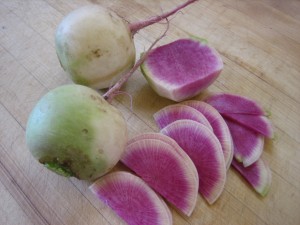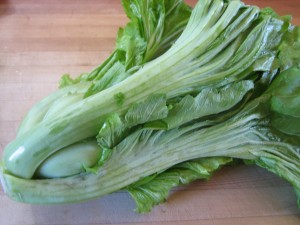Frugality is instilled in most Hakkas. It’s a characteristic that likely helped them to survive when they lived in poor isolated areas. They learned to be resourceful with what they had. It’s a trait I have. I find it difficult to throw anything out if there is another good use for it.
After making more than ten batches of Pickled Mustard Greens for a tasting for a 180 guests in December, I was left with lots of sweet-sour pickling solution. Instead of pouring it down the sink, I kept the sugar/vinegar solution in clean yogurt containers (I recycle those, too) in the refrigerator. I had some leftover cabbage, the common round green cabbage. I decided to pickle it. I blanched bite-sized pieces briefly in boiling water, just like the broad-stemmed mustard greens, rinsed it with cold water and immersed it in the sugar-vinegar solution, and placed it in the refrigerator. After a few days, the cabbage was crunchy and sweet-sour. It lacks the pungency of the mustard greens, but still is a delightful pickle although the color is a bit pale. With red cabbage, the color is deep purple and the liquid turns pink.

Cut watermelon radish into thin slices and drop into vinegar-sugar mixture to make easy sweet-sour pickles.
I have also pickled other vegetables. My latest find at the farmers’ market was watermelon radishes. These large green-tinged white radishes don’t look like much on the outside, but cut it open to reveal the red interior that resembles watermelon. Peel, cut in half lengthwise, then thinly slice and immerse in the pickling solution, and refrigerate for a few days. No need to blanch first. The liquid will turn pink.
Treat jicama the same way, except I cut the jicama into sticks. Do the same thing with cucumbers, except I use the cucumbers unpeeled. With vegetables with a high moisture content such as these, blanching isn’t necessary. Once the pickling solution tastes watery, discolors, or gets cloudy, I’ll dump it. Probably can reuse it once or twice. So far, I’ve reaped a bumper crop of new pickles just by being frugal.

